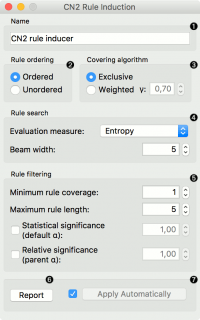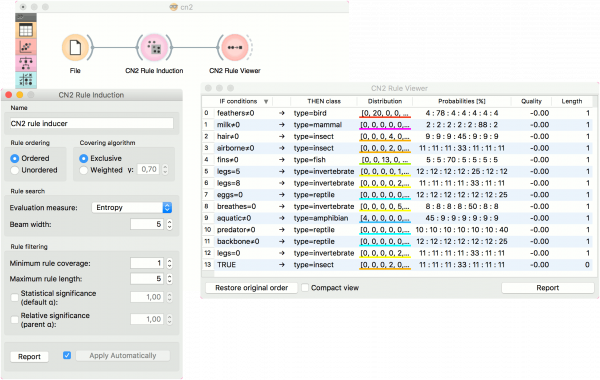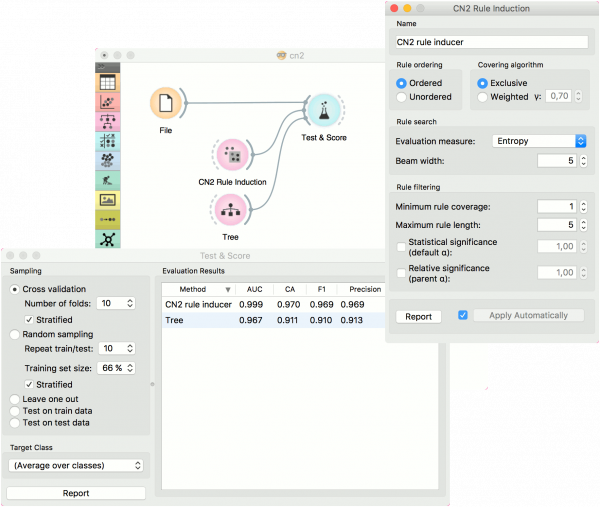Difference between revisions of "Orange: CN2 Rule Induction"
Jump to navigation
Jump to search
Onnowpurbo (talk | contribs) (→Contoh) |
Onnowpurbo (talk | contribs) (→Contoh) |
||
| Line 46: | Line 46: | ||
Dalam contoh di bawah, kita menggunakan dataset zoo dan mengirimkannya ke CN2 Rule Induction. Kita bisa me-review dan meng-interpretasi model yang dibuat dengan CN2 Rule Viewer widget. | Dalam contoh di bawah, kita menggunakan dataset zoo dan mengirimkannya ke CN2 Rule Induction. Kita bisa me-review dan meng-interpretasi model yang dibuat dengan CN2 Rule Viewer widget. | ||
| − | [[File:CN2-visualize.png|center| | + | [[File:CN2-visualize.png|center|600px|thumb]] |
Workflow yang ke dua men-test evaluasi CN2 Rule Induction dan Tree di Test & Score. | Workflow yang ke dua men-test evaluasi CN2 Rule Induction dan Tree di Test & Score. | ||
| − | [[File:CN2-classification.png|center| | + | [[File:CN2-classification.png|center|600px|thumb]] |
==Referensi== | ==Referensi== | ||
Revision as of 04:06, 10 April 2020
Sumber: https://docs.biolab.si//3/visual-programming/widgets/model/cn2ruleinduction.html
Induce rule dari data menggunakan algoritma CN2.
Input
Data: input dataset Preprocessor: preprocessing method(s)
Output
Learner: CN2 learning algorithm CN2 Rule Classifier: trained model
Algoritma CN2 adalah teknik klasifikasi yang di rancang agar secara effisien melakukan induksi dari rules yang simple & komprehesif dalam bentuk “if cond then predict class”, meskipun dalam domain dimana mungkin ada noise.
CN2 Rule Induction hanya bisa jalan untuk klasifikasi saja.
- Name under which the learner appears in other widgets. The default name is CN2 Rule Induction.
- Rule ordering:
- Ordered: induce ordered rules (decision list). Rule conditions are found and the majority class is assigned in the rule head.
- Unordered: induce unordered rules (rule set). Learn rules for each class individually, in regard to the original learning data.
- Covering algorithm:
- Exclusive: after covering a learning instance, remove it from further consideration.
- Weighted: after covering a learning instance, decrease its weight (multiplication by gamma) and in-turn decrease its impact on further iterations of the algorithm.
- Rule search:
- Evaluation measure: select a heuristic to evaluate found hypotheses:
- Entropy (measure of unpredictability of content)
- Laplace Accuracy
- Weighted Relative Accuracy
- Beam width; remember the best rule found thus far and monitor a fixed number of alternatives (the beam).
- Evaluation measure: select a heuristic to evaluate found hypotheses:
- Rule filtering:
- Minimum rule coverage: found rules must cover at least the minimum required number of covered examples. Unordered rules must cover this many target class examples.
- Maximum rule length: found rules may combine at most the maximum allowed number of selectors (conditions).
- Default alpha: significance testing to prune out most specialised (less frequently applicable) rules in regard to the initial distribution of classes.
- Parent alpha: significance testing to prune out most specialised (less frequently applicable) rules in regard to the parent class distribution.
- Tick ‘Apply Automatically’ to auto-communicate changes to other widgets and to immediately train the classifier if learning data is connected. Alternatively, press ‘Apply‘ after configuration.
Contoh
Dalam contoh di bawah, kita menggunakan dataset zoo dan mengirimkannya ke CN2 Rule Induction. Kita bisa me-review dan meng-interpretasi model yang dibuat dengan CN2 Rule Viewer widget.
Workflow yang ke dua men-test evaluasi CN2 Rule Induction dan Tree di Test & Score.
Referensi
- Fürnkranz, Johannes. “Separate-and-Conquer Rule Learning”, Artificial Intelligence Review 13, 3-54, 1999.
- Clark, Peter and Tim Niblett. “The CN2 Induction Algorithm”, Machine Learning Journal, 3 (4), 261-283, 1989.
- Clark, Peter and Robin Boswell. “Rule Induction with CN2: Some Recent Improvements”, Machine Learning - Proceedings of the 5th European Conference (EWSL-91),151-163, 1991.
- Lavrač, Nada et al. “Subgroup Discovery with CN2-SD”,Journal of Machine Learning Research 5, 153-188, 2004


